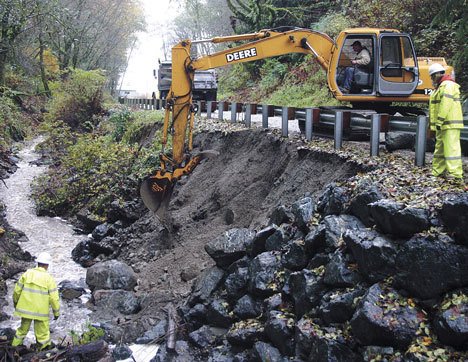The sound could be heard blocks away — water swollen by recent heavy rains rushing down the bed of Glendale Creek.
Following days of heavy precipitation, a combination of rocks and silt from the hillside above swept down on Tuesday and threatened the 10 homes that are only now recovering from April’s Flood of ’09.
Another beaver dam may have been the culprit.
And sitting square in the path of the turbulent stream was the home of Glendale resident Lorinda Kay, threatened again by a deluge.
Kay said she watched as water again began to pond in the same place that started this year’s earlier flood.
“Water was backed up in the field next to Cultus Bay Road close to the Red Door farm,” Kay said.
“There wasn’t the volume of water that was held back in April, but the field was flooded with standing water.
“Sometime on Monday night or early Tuesday, the dam broke apart,” Kay said.
Debris rushing down the creek collected at the culvert just above the old Ford garage in Glendale, Kay said, and created a 4-foot-high waterfall.
The creek also filled again with silt, which threatened to push the water over the banks and toward homes in the neighborhood.
Some residents in Glendale began to worry about a repeat of April’s maelstrom, caused by a broken beaver dam that had washed away Glendale Road a mile upstream. The muck washed through the lower level of homes, damaging many and pushing one from its foundation. It dumped a mountain of mud and debris along the seawall, sweeping away decks and blanketing lawns.
This time, the county responded quickly, sending two dozen workers and heavy equipment to the scene on Tuesday. They began filling and placing sandbags to create a diversion channel as the creek continued to rise.
County workers placed about 400 sandbags along the lowest point of the creek to the seawall, creating an emergency channel for water should it overflow the banks of the creek. Sandbags stretched across Humphrey Road to the last section of the creek by the seawall in an effort to contain any overflowing water.
County officials were concerned that if the dam created by the debris broke apart, a lot of material could wash down the creek and possibly block the culverts, overflowing down the road.
Late Wednesday, residents were starting to get really worried.
“The volume of water flowing through the creek now looks like a roaring river,” said local homeowner Joan Smith. “And they are looking at a 12-foot tide that will make it hard for the water to flow into the Sound.”
But people were glad to see all the men, equipment and sand bags in Glendale when they arrived home that evening, Kay said. A county worker and a backhoe remained on hand all night in case emergency measures were needed.
Officials were confident the problem was contained, if not solved.
“We moved sediment from the lower 200 feet of the creek bed, repaired a creek bank and removed some rocks clogging the culvert under the road,” said Island County Public Works director Bill Oakes. “By Thursday morning, it appeared the water’s velocity was high enough to move the silt into the sound and the water level had dropped roughly two feet.
“We’re examining whether the beaver dam upstream contributed to the problem,” Oakes noted. “There are serious remnants of silt that, combined with a higher flow rate, are creating this problem.”
Oakes said the county did what it could.
“I think we responded quickly, and they appreciated our response,” he said of the Glendale residents.
By early Friday, the worst was over. For now.
“The creek is backing up a bit from an incoming tide, which is normal,” Kay said. “There’s less water so the immediate danger is past, but its going to take time for the creek to repair itself.
“A careful watch will need to be continued through the winter months.”
Jeff VanDerford can be reached at 221-5300 or jvanderford@southwhidbeyrecord.com.




